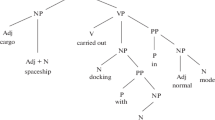Abstract
In syntactic pattern recognition a pattern is represented by abstract data, for instance a graph. The problem of recognition is to determine if a pattern, represented by the describing graph, belongs to a language L(G), generated by a graph grammar G. The so-called IE graphs can be used for a pattern description. They are generated by so-called ETPL(k) graph grammars. The purpose of this paper is to present an idea of a new approach to syntactic recognition of fuzzy patterns represented by fuzzy IE graphs, followed the example of random IE graphs. This methodology can be used for analysis of wider class of patterns and scenes than the one described by the classical syntactic methods. In this paper, apart from the presentation of the fuzzy-aided approach, it is also shown that the probabilistic-syntactic approach is a special case of the presented one.
Access this chapter
Tax calculation will be finalised at checkout
Purchases are for personal use only
Preview
Unable to display preview. Download preview PDF.
Similar content being viewed by others
References
Bielecka M (2006) A method of membership function construction in fuzzy systems. In: Cader A, Rutkowski L, Tadeusiewicz R, Zurada J (eds) Challenging Problems of Science-Computer Science, Academic Publishing House EXIT, Warszawa, 111–117
Bielecka M, Skomorowski M, Bielecki A(2007) Fuzzy-syntactic approach to pattern recognition and scene analysis. Proceedings of the 4th International Conference on Informatics in Control, Automatics and Robotics ICINCO’07, ICSO-Intelligent Control Systems and Optimization, Robotics and Automation, vol. 1, 29–35
Chen SL, Chen Z, Li RK(1991) A DGR method for extracting the topology of an upper-half profile of a turned part from CAD data. Computer Integrated Manufacturing 4: 45–56
Ferber J(1999) Multi-Agent Systems. An Introducing to Distributed Artificial Intelligence. Addison-Wesley, Harlow
Flasiński M(1993) On the parsing of deterministic graph languages for syntactic pattern recognition. Pattern Recognition 26: 1–16
Flasiński M, Skomorowski, M(1998) Parsing of random graph languages for automated inspection in statistical-based quality assurance systems. Machine Graphics and Vision 7: 565–623
Fu KS (1982) Syntactic Pattern recognition and Application. Prentice Hall, New York
Han M, Han H (1999) Automating focusing vision system for inspection of size and shape of small holes. Journal of the Korean Society of Precision Engineering 16: 80–86
Jakubowski R (1997) Structural approach to modelling and analysis of 2D-shapes. Bull. Polish Academy of Sciences-Technical Sciences 45: 373–387
Jakubowski R, Stapor K(1999) Structural method in prceptual organization of 2D-curve detection. Bull. Polish Academy of Sciences-Technical Sciences 47: 309–324
Muratet L, Doncieux S, Briere Y, Meyer JA(2005) A contribution to vision-based autonomous helicopter flight in urban environment. Robotics and Autonomous Systems 50: 195–229
Noori H., Radford R(1995) Production and Operation Management-Tostal Quality and Responsiveness. McGraw Hill
Ogiela M, Tadeusiewicz R, Ogiela L(2006) Image languages in inteligent radiological palm diagnosis. Pattern Recognition 39: 2157–2165
Rutkowski L (2005) Artificial Intelligence Techniques and Methods. PWN, Warszawa (in Polish)
Scheier C, Pfeifer R(1999) The embodied cognitive science approach. In: Tschacher W, Dauwalde J.P. (eds) Dynamics, Synergetics, Autonomous Agents, Studies of Nonlinear Phenomena and Life Science, vol. 8, World Scientific, Singapore, 159–179
Skomorowski, M(1999) Use of random graph parsing for scene labeling by probabilistic relaxation. Pattern Recognition Letters 20: 949–956
Tadeusiewicz R, Ogiela M(2005) Picture languages in automatic radiological palm interpretation. Int. J. Appl. Mathematics and Computer Science 15: 305–312
Author information
Authors and Affiliations
Editor information
Editors and Affiliations
Rights and permissions
Copyright information
© 2007 Springer-Verlag Berlin Heidelberg
About this paper
Cite this paper
Bielecka, M., Skomorowski, M. (2007). Fuzzy-aided Parsing for Pattern Recognition. In: Kurzynski, M., Puchala, E., Wozniak, M., Zolnierek, A. (eds) Computer Recognition Systems 2. Advances in Soft Computing, vol 45. Springer, Berlin, Heidelberg. https://doi.org/10.1007/978-3-540-75175-5_39
Download citation
DOI: https://doi.org/10.1007/978-3-540-75175-5_39
Publisher Name: Springer, Berlin, Heidelberg
Print ISBN: 978-3-540-75174-8
Online ISBN: 978-3-540-75175-5
eBook Packages: EngineeringEngineering (R0)




